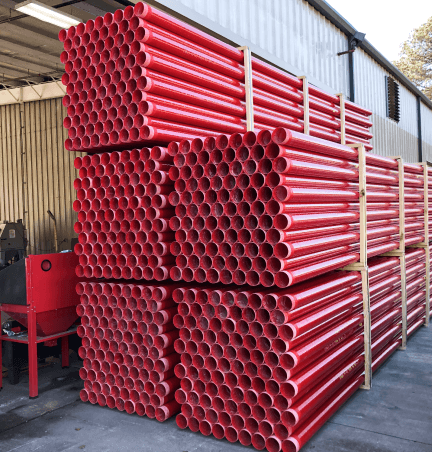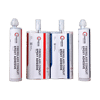AES Corporation, a clean energy company, was planning a new solar farm in Charles City, Virginia. Called the Skipjack Solar Center, the facility is built on former working timber land.
This project consisted of the installation of five 35 kV circuits in a single 3.2 mile corridor. Each circuit has the capacity of transmitting 44 MW of solar generation (a total of 220 MW) to the grid. Construction included underground burial of conduit encased wire (0.75 mile in one continuous pull), as well as pole risers. The project involved significant trenching and the navigation of material shortages due to COVID-19.
Phase two of the project included a 230kV underground transmission gentie (generator tie line), capable of transmitting 320 MW of solar generation to the grid. Installation involved a 4,500 foot duct bank with a continuous run (long pull) of 230 kV underground transmission cables through cultivated fields between two new H-frame riser structures. Contractor Booth & Associates and their subsidiaries provided full engineering, equipment procurement, management and construction.
CHALLENGE
This solar project presented a number of challenges. First, there were multiple circuits coming through the project. An interconnection facility was designed and installed bringing the solar facility to the grid. This involved five 35 kV circuits along 4 to 5 miles of cable to a new substation where voltage stepped up to 230 kV to connect underground to the grid.
Additionally, there were special requirements for long segment installation due to landowner agreements forcing overhead lines underground. Buried installation posed a challenge as concrete encased duct banks can be a bit more complex than other types of installation. The engineers and project managers desired to eliminate as much cable, conduit and equipment as possible.
The last challenge was procurement due to COVID-19 product delays. Lead times and costs of some products such as PVC conduit were long.
SOLUTION
The engineers and project managers developed a scenario running cable underground in a straight line pull. Fiberglass conduit was ideal for the job due to its broader temperature range, up to 250 F (121 0C), so it tolerates more heat. PVC conduit was not seriously considered due to its limited temperature
range. Fiberglass conduit allowed for the maximum cable rating of 105 0C for this project. The more capacity a conduit can hold, the more heat is generated, so temperature range was a key factor in conduit selection.
Use of fiberglass conduit allowed project managers to consider a more straight forward burial type. Durable, corrosion-resistant medium wall (MW) and heavy wall (HW) conduit provided mechanical protection so the conduit and cable could be buried directly without the need to pour concrete.
Champion Fiberglass® conduit (55,000 feet) was procured within a faster time frame, 6 to 8 weeks, half the time of other conduit types that were experiencing supply chain issues.
Installation was easy. Trenches, 60 to 80 feet, were buried, conduit was laid and connected with a slip fit connection that was hammered into place. There was no need for epoxy, so fewer materials were needed and installation took less time.
RESULTS
- Optimized design included durable, corrosion-resistant fiberglass conduit capable of handling a significant cable load due to its wide temperature range.
- Product secured in half the time of competing conduit. Low material costs were easy on project budgets.
- A complex project with significant underground burial in tight corridors was streamlined with an installation that shaved weeks off the timeline, enabling the contractor to meet important deadlines.
- Excellent customer service helped the project reach a successful conclusion.












